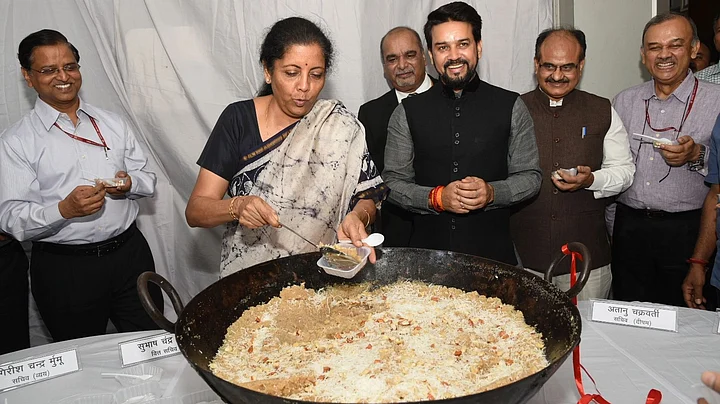(Got questions about Union Budget 2023? Join our exclusive discussion with Raghav Bahl on 3 February – and get them answered. Become a member to get your invite.)
Every year, as the day to present the Union Budget in Parliament draws closer, several phrases start doing the rounds. Among the financial jargon, two non-financial terms stick out – 'halwa ceremony' and 'bahi khata'.
While the halwa ceremony is an age-old tradition passed on for years, carrying the 'bahi khata' or a traditional Indian ledger was recently introduced by Finance Minister Nirmala Sitharaman to renounce the "colonial-era practice" of carrying a leather briefcase.
Significance of Halwa Ceremony
Sitharaman will be presenting Budget 2023 on 1 February, the tone of which was set on Thursday, 26 January, when she performed the 'halwa ceremony' at the Finance Ministry headquarters in New Delhi.
In attendance were Ministers of State (MoS) for Finance Pankaj Chaudhary and Dr Bhagwad Kishanrao Karad, along with Secretaries of the Finance Ministry, Chairman of the Central Board of Direct Taxes (CBDT) and Central Board of Indirect Taxes and Customs (CBIC).
Last year, the ceremony was modified a bit, keeping in line with the health safety concerns amid the pandemic.
The ceremony marks the final stage of preparing the Union Budget. The finance minister begins the ceremony by stirring the halwa, a popular Indian sweet dish, in the kadhai (wok) and then serves it to their colleagues at the ministry's headquarters in Delhi. The Ministers of State and other top officials are also present during the ceremony.
After the ceremony, the final stage of the process begins, which traditionally would have been the printing of Budget documents. In 2021, for the first time ever, the process had become paperless owing to COVID-19 restrictions.
The 'halwa ceremony' assumes significance because after it is over, all officials of the finance ministry who were involved in the Budget-making process are supposed to be locked in at the North Block of the finance ministry till the Budget is presented in Parliament. The North Block houses the printing press on which documents related to the Budget have been printed from 1980 till 2020.
The officials have to remain cut off from their families for nearly 10 days till the Budget is presented so as to maintain absolute secrecy and prevent any leaks. The finance minister is the only one who is allowed to walk in and out of the building.
The ceremony also recognises the effort of the officials who are involved in the long-drawn Budget-making process.
The 'Bahi Khata'
The day of the Budget was usually accompanied with images of the finance minister walking to the Parliament carrying a briefcase, which contained documents related to the Budget and the Budget Speech.
However, in 2019, Finance Minister Nirmala Sitharaman replaced the briefcase with a traditional 'bahi khata' so as to relinquish what she labelled as a "colonial practice."
In 2021, for the first time ever, the Union Budget saw a digital transformation and was presented in a 'paperless' manner amid the COVID-19 pandemic. Sitharaman had read the Budget speech from a tablet that year and the next.
The move was also seen as an effort by Prime Minister Narendra Modi to push for digitisation.
A 'Bahi Khata' is like a ledger that Indian households and small enterprises maintain to manage their expenses.
The Budget Briefcase
During pre-Independence times, British finance ministers used to arrive at Parliament to present the Budget carrying a Gladstone Box, which was eventually replaced with briefcases after India became a free nation.
While India's first finance minister RK Shanmukham Chetty carried a leather portfolio bag to present the Budget, the practice evolved to carrying a hardbound bag around the 1970s.
The colour of these bags have often changed, but Finance Minister Nirmala Sitharaman carried a red 'Bahi Khata' in 2019, heralding a new chapter in the history of presenting the Union Budget.
